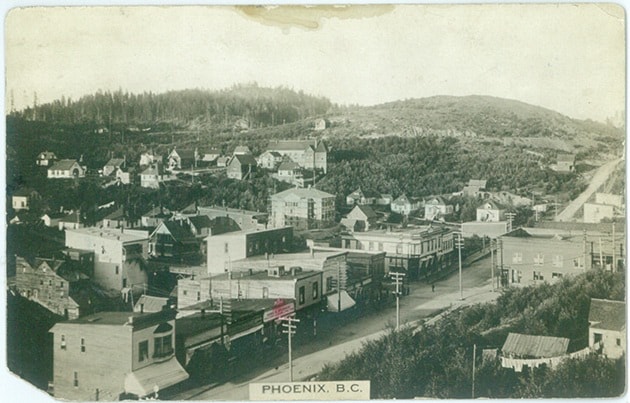One hundred forty-ninth in an alphabetical series on West Kootenay/Boundary place names
In Greek mythology, the phoenix is a bird that regenerates itself by rising from the ashes of its predecessor. It turned out to be a prophetic name for the Boundary’s greatest ghost town.
Phoenix was originally known as Greenwood Camp and first mentioned in an item in the Vernon News, reprinted in the Victoria Daily Colonist on Jan. 21, 1894: “It is reported that Eastern capitalists are negotiating for the … Knob Hill and Ironsides [mining claims] in Greenwood Camp.” (We’ve previously looked at how Greenwood got its name.)
Within Greenwood Camp was the Phoenix claim. The Boundary Creek Times of March 19, 1898 said it was located by Thomas McDonnell, Robert Denzler, and James Scofield in 1894, although its earliest mention wasn’t until the Nelson Miner of July 27, 1895: “The Greenwood claims lie in a narrow, timbered valley to the west of which lie the Nob [sic] Hill, Ironsides, Brooklyn, Phoenix, and Stemwinder …”
A few sources, including the Boundary Historical Society’s Eighth Report (1979), say the claim was originally called the Silver King, and that Denzler relocated it and renamed it the Phoenix, “perhaps envisioning its rebirth in a lucky future.”
Lois Haggen wrote in the Boundary Historical Society’s Sixth Report (1971): “Local people say it was named after Phoenix, Arizona. I notice [journalist] Bruce McKelvie claims it was named after the mythical phoenix of Egypt … Mr. McKelvie is usually accurate when he records history … but I am of the opinion that our old timers, to many of whom I have spoken … will stick to their contention that it was named after the American city.”
Phoenix, Arizona in the mid-1890s was an important city but its population was less than 5,500. Did it merit a mining claim in its honour? Hard to say. Other Phoenix claims existed in neighbouring camps.
The Boundary Creek Times of June 25, 1898 reported: “A small town is springing up in Greenwood camp. A general store has been opened by Messrs. Winkop and Stevens and application has been made to the post office department for a post office to be known as Brooklyn.”
Brooklyn was the name of another promising mine in the camp. However, it was also the name of a railway boomtown on Lower Arrow Lake that had come to life only a few weeks earlier and survived just long enough to prevent the post office at Greenwood Camp from becoming known as Brooklyn (although it didn’t stop the Brooklyn Hotel from opening).
On July 30, 1898 the Times reported: “The [post office] department has granted a post office for Greenwood camp, calling it Greenwood Camp P.O. This name is not satisfactory as it is likely to conflict with Greenwood P.O. The department has been requested to change the name to Knob Hill or Phoenix.”
The same newspaper confirmed on Aug. 13: “The post office in Greenwood camp is to be called Phoenix.” However, it added on Sept. 3: “The post office department is exceedingly slow in establishing an office in Greenwood camp. Some two months ago the department decided to establish a post office there but the post office inspector has so far failed to make the necessary arrangement.”
On the same day the Victoria Daily Colonist wrote: “Sixteen miles from Grand Forks, on the government wagon road to Greenwood City and in the heart of Greenwood camp, is starting a new settlement known as Phoenix post office, that promises to become a lively little town in the near future.”
The Boundary Creek Times announced on Oct. 1: “Thomas Roderick has received a letter from post office inspector Fletcher to the effect that the necessary material for a post office has been shipped from Vancouver and that the Phoenix post office [is] to be opened.”
In fact, the office opened that day.
John Coryell surveyed the Phoenix townsite in June 1899. Phoenix was incorporated as a city in 1900 — it claimed to have the highest elevation of any city in Canada, at 1,412 m — and thrived for 20 years as a major copper camp until prices collapsed with the end of World War I. The Granby Company then closed its mines and focused operations on Anyox and Princeton, where many Phoenicians moved.
The Phoenix post office closed in 1920 and the city disincorporated the following year. But the mines re-opened in 1924, 1936-42, and 1959-78. The latter was an open pit operation that obliterated any sign of the old town, except for the cemetery and cenotaph.
Robert Denzler (1850-1944), the American prospector who may have named the Phoenix claim, is buried in Greenwood.
Previous installments in this series
Applegrove, Appleby, and Appledale revisited
Bakers, Birds, and Bosun Landing
Bannock City, Basin City, and Bear Lake City
Bealby Point (aka Florence Park) revisited
Boswell, Bosworth, Boulder Mill, and Broadwater
Brooklyn, Brouse, and Burnt Flat
Camborne, Cariboo City, and Carrolls Landing
Carmi, Cedar Point, Circle City, and Clark’s Camp
Carson, Carstens, and Cascade City
Christina City and Christian Valley
Cody and Champion Creek revisited
Champion Creek revisited, again
Columbia City, Columbia Gardens, and Columbia Park
Crawford Bay and Comaplix revisited
Dawson, Deadwood, and Deanshaven
English Cove and English Point
Forslund, Fosthall, and Fairview
Fort Shepherd vs. Fort Sheppard, Part 1
Fort Shepherd vs. Fort Sheppard, Part 2
Gladstone and Gerrard, revisited
Hall Siding and Healy’s Landing
Hudu Valley, Huntingtdon, and Healy’s Landing revisited
Inonoaklin Valley (aka Fire Valley)
Jersey, Johnsons Landing, and Jubilee Point
Kootenay Bay, Kraft, and Krestova
Kuskonook (and Kuskanax), Part 3
Labarthe, Lafferty, and Longbeach
Makinsons Landing and Marblehead
McDonalds Landing, McGuigan, and Meadow Creek
Meadows, Melville, and Miles’ Ferry
Mirror Lake and Molly Gibson Landing
Montgomery and Monte Carlo, Part 1
